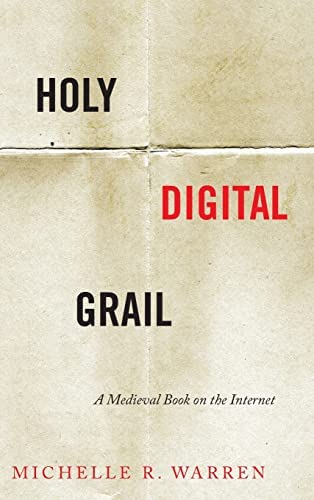
Michelle Warren, Professor of Comparative Literature at Dartmouth College, merges book history, digital humanities, and library science in her new book Holy Digital Grail. The novel follows the evolution of one manuscript, MS 80. At Dartmouth, Warren teaches medieval studies, translation studies, and postcolonial studies.
In my many years as an avid reader, never have I read a book with in-text citations. The preface to Holy Digital Grail explains Warren’s choice to include the citations immediately after the sentence instead of via the more traditional method of footnoting found in academic works of great length (Warren 2022, xii). Warren found that in-text references liberate her words from the confines of the written page and allow digital readers greater accessibility, enabling her to create the most easily adapted book possible. For those looking to use Holy Digital Grail as a reference, this decision will not interfere with any aspect of your experience. However, if one attempts to read the book in its entirety, the in-text references are distracting. There is, at its core, a strong narrative to the novel, but at times I felt far removed from the work and caught up in citations.
The introduction pontificates on what it means for a book to be a book and on Warren’s thoughtful approach to her own book. “Some have been annotated by thoughtful readers; others have been treated as scrap paper,” says Professor Warren (Warren 2022, 1). MS 80, the book in question, currently exists in a vault at Parker Library, Corpus Christi College, Cambridge. There are four seats in the Parker Library, an exclusive space befitting the exclusive texts it houses. Matthew Parker, after whom the library is named, was the first Archbishop of Canterbury. For anyone interested in book history, Parker Library is an essential visit. The contents of the library are open only to researchers and are only accessible on a case-by-case basis. MS 80 is one of the more than 600 manuscripts in the library’s collection.
Warren begins her first chapter, “Translating Arthur,” by giving readers a very necessary summary of the events and various plots of Arthurian legend. The legend possesses a rich history and was passed around more than I ever realized. There is a strong (almost disgustingly so) French influence to be found in the lines of MS 80. The primary translator of the French prose, Henry Lovelich, is considered the reason for the lack of notoriety surrounding MS 80. Some say he was a “bad translator.” Modern translation theory, however, would point towards Lovelich as something of a maverick, using “extensive word-borrowing” which others might view as careless (Warren 2022, 46). Warren also discusses the exact layout of the manuscript—two large columns of text on grand sheets of paper, a great luxury at the time of its manufacture. In “Translating Arthur,” MS 80’s value and cultural significance is made clearer, effectively luring me in to hear its story.
Originally, the manuscript was made for the London Skinners’ Guild. For those needing a history refresher, skinners are purveyors of furs, making them one of the wealthier and more educated merchants’ guilds. Books in the Middle Ages were seen as a store of wealth like any other investment. MS 80 encompasses many different genres enjoyed by merchants such as the life of a saint, moral lessons, feats of valor, and royal history (Warren 2022, 81). Henry Barton, who commissioned Lovelich to translate MS 80, was a skinner in the service of the royal family, in charge of the care and keeping of the royal furs.
The third chapter, “Marking Manuscripts,” is particularly striking. The large margins of MS 80 are littered with everything from signatures, lengthy Latin conjugations, and titles to the history of the book itself. “Oute of ffrensshe in to englysshe (out of French into English)” reads the margin next to Lovelich’s name (Warren 2022, 118). Being such an extensive work, MS 80 is shrouded in its own context. The centuries of annotations on the text clearly represent a study entirely of their own to Warren, who sees the annotations as alive and moving.
As the novel continues, I continue to be overwhelmed by the sheer amount of history following one relatively unknown Arthurian manuscript. MS 80’s translation onto the internet, as discussed in the sixth chapter, “Reproducing Books,” proved a tedious yet worthwhile process. Through the digitization of otherwise gate-kept resources such as the Parker Library, scholarly experiences become more accessible to those unable to travel to the physical space. Democratizing medieval manuscripts is undoubtedly the best method to remove privilege from academia.
To understand Warren’s Holy Digital Grail, I suggest one be well versed in the content of MS 80. Or, at least, know what MS 80 is. Michelle Warren says in her conclusion that her publishers worried “a book about one book won’t get very far.” (Warren 2022, 275). In truth, Warren’s book is weighed down by her knowledge of MS 80 that far surpasses that of the uneducated reader, and probably surpasses that of even her colleagues. Holy Digital Grail contains characters—iconic plots, locations, and scholars—many of whom never feel fully unpacked. Holy Digital Grail is an ideal reference work for those in the field of book studies, library science, and the like. In a digital form, such as a PDF, Warren’s inventive use of in-text citations and careful organization would be supremely helpful. In a paperback book, the references prove excessive.
Every time I take a class in the Comparative Literature program, I think, “I will never take a class in Comparative Literature again.” Despite Warren’s clear expertise and intelligence, Holy Digital Grail represents the same attitude found all throughout her program, overwrought with care for the genuinely unimportant and ignoring the interests of the curious masses.

Be the first to comment on "Holy Digital Grail: A Review"